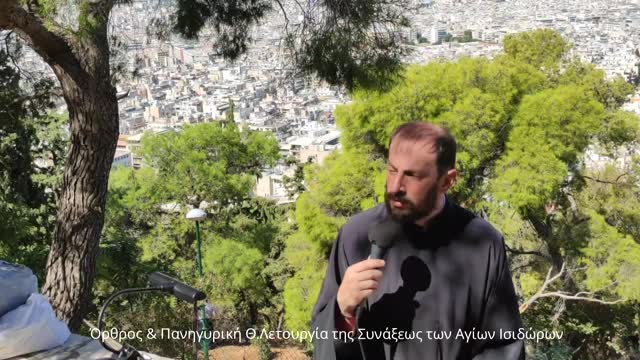Premium Only Content

September 27, 2021 | Feast of the Synaxis of Saints Isidore | Greek Orthodox Divine Liturgy Live
Saint Isidore of Pelusium lived during the fourth-fifth centuries. He was a native of Alexandria, and was raised among pious Christians. He was a relative of Theophilus, Archbishop of Alexandria, and of his successor, Saint Cyril (January 18). While still a youth he quit the world and withdrew to Egypt to Mount Pelusium, which became the site of his monastic efforts.Saint Isidore’s spiritual wisdom and strict asceticism, combined with his broad learning and innate knowledge of the human soul, enabled him to win the respect and love of his fellow monks in a short time. They chose him as their head and had him ordained a priest (the earliest sources for his life, however, say nothing of him being an igumen).
Following the example of Saint John Chrysostom, whom he had managed to see and hear during a trip to Constantinople, Saint Isidore devoted himself primarily to Christian preaching, that “practical wisdom” which, in his own words, is both “the foundation of the edifice and the edifice itself”, while logic is “its embellishment, and contemplation its crown”.He was a teacher and a willingly provided counsel for anyone who turned to him for spiritual encouragement, whether it was a simple man, a dignitary, a bishop, the Patriarch of Alexandria, or even the emperor. He left behind about 10,000 letters, of which 2,090 have survived. A large portion of these letters reveal profound theological thought and contain morally edifying interpretations of Holy Scripture. Saint Photius (February 6) calls Isidore a model of priestly and ascetical life, and also a master of style.
Saint Isidore’s love for Saint John Chrysostom resulted in his support of Saint John when he was persecuted by the empress Eudoxia and Archbishop Theophilus. After the death of Saint John, Saint Isidore persuaded Theophilus’ successor Saint Cyril to inscribe the name of Saint John Chrysostom into the Church diptychs as a confessor. Through the initiative of Saint Isidore the Third Ecumenical Council was convened at Ephesus (431), at which the false teaching of Nestorius concerning the person of Jesus Christ was condemned.Saint Isidore lived into old age and died around the year 436. The Church historian Evagrius (sixth century) writes of Saint Isidore, “his life seemed to everyone the life of an angel upon the earth.” Another historian, Nikēphóros Callistus (ninth century), praises Saint Isidore thus: “He was a vital and inspired pillar of monastic rules and divine vision, and as such he presented a very lofty image of most fervent example and spiritual teaching.”
Saint Isidore of chios lived during the reign of Emperor Decius (249-251) and came from Alexandria in Egypt. He was an officer in the Roman Navy when the fleet commanded by Admiral Numerius chanced to be anchored off the Greek island of Chios. There Christianity was not persecuted, and perhaps Saint Isidore was not as cautious as he should have been. Somehow, the centurion Julius discovered that Isidore was a Christian, and denounced him to Admiral Numerius.
The Admiral summoned him in order to determine whether or not the allegation was true. Saint Isidore admitted that he was indeed a Christian, and refused to offer sacrifice to inanimate idols. Numerius urged him to obey the Emperor's decree to offer sacrifice so that he would not be subjected to torture. Saint Isidore replied, "You may be able to kill my body, but you have no power over my soul. The true, living God, Jesus Christ, abides in me; even after my death He shall be with me, and I with Him. I shall abide in Him, and I shall never cease to confess Him while breath still remains in my body."Saint Isidore was led away to be tortured. In the midst of his suffering, he praised Christ God and mocked the pagan idols. Since Saint Isidore still refused to offer the prescribed sacrifice, he was thrown into prison.
Watch live from the Greek Orthodox Church of Saint Isidoroi at Lycabettus hill, the Matins/Orthros and the Divine Liturgy . The small church of Saint isidoroi belongs to the Holy Archdiocese of Athens and is located on the west side of Lycabettus Hill in Athens, built inside the largest cave on the hill. According to tradition, this cave was a place of ascetic life of the Christians of the first centuries.
-
 2:27:34
2:27:34
Greek Orthodox Church St. Isidoroi, Athens, Greece
2 years agoNovember 4, 2022, St. George Karslidis the Confessor | Greek Orthodox Divine Liturgy
87 -
 11:39
11:39
Russell Brand
1 day agoWhat You're Not Being Told About The Syrian War
112K195 -
 DVR
DVR
Bannons War Room
1 year agoWarRoom Live
101M -
 1:49:21
1:49:21
Film Threat
5 hours agoBEST AND WORST OF 2024 + SQUID GAME SEASON 2 | Film Threat Livecast
18.6K1 -
 1:06:04
1:06:04
The Big Mig™
18 hours agoGlobal Finance Forum Powered By Genesis Gold Group
18.7K2 -
 34:38
34:38
Tudor Dixon
3 hours agoThe Changing Landscape Between Tech and Politics with Mike Benz | The Tudor Dixon Podcast
12.5K1 -
 2:23:58
2:23:58
Matt Kohrs
14 hours agoRumble's Stock Is EXPLODING!!! || The MK Show
68.6K6 -
 1:57:47
1:57:47
LFA TV
16 hours agoBOMBSHELL FINAL REPORT: BIDEN ADMIN SUPPRESSED WUHAN LAB LEAK | LIVE FROM AMERICA 12.27.24 11am EST
36.7K5 -
 43:07
43:07
Grant Stinchfield
2 hours ago $2.68 earnedWe Built it... China Controls it... Trump Will Take it Back!
15.1K7 -
 35:05
35:05
Rethinking the Dollar
2 hours agoTime to Pay the Piper! Debt Refinance Crisis Coming in 2025
17K2